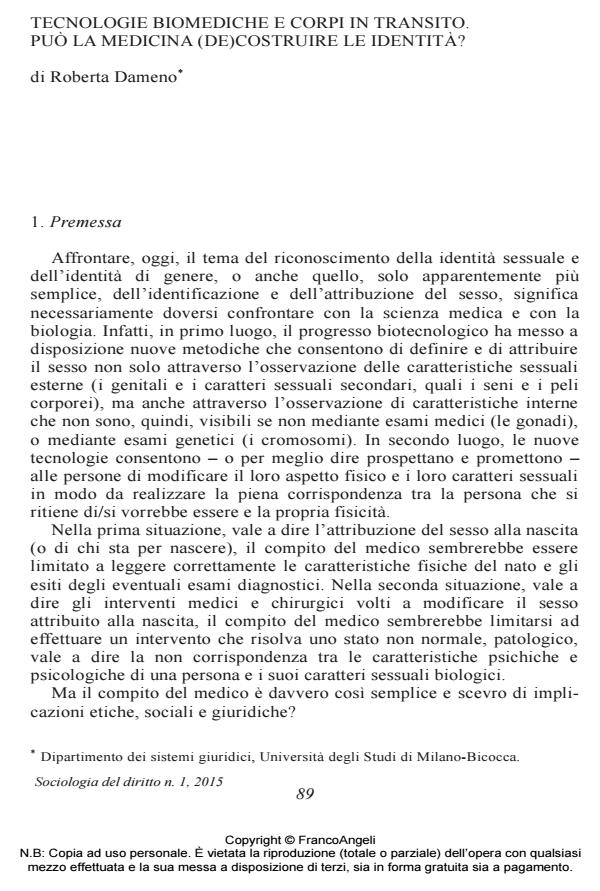Biomedical technologies and bodies in transition: can medicine de(construct) identities?
Journal title SOCIOLOGIA DEL DIRITTO
Author/s Roberta Dameno
Publishing Year 2015 Issue 2015/1 Language Italian
Pages 14 P. 89-102 File size 108 KB
DOI 10.3280/SD2015-001004
DOI is like a bar code for intellectual property: to have more infomation
click here
Below, you can see the article first page
If you want to buy this article in PDF format, you can do it, following the instructions to buy download credits

FrancoAngeli is member of Publishers International Linking Association, Inc (PILA), a not-for-profit association which run the CrossRef service enabling links to and from online scholarly content.
An individual’s sexual condition and characteristics are the primary elements for defining that person’s identity and for him or him to be recognised in society. As a result of modern medicine, however, the individual’s sexual characteristics are no longer an unchangeable fact, but can be modified, so that people are free to deconstruct and reconstruct their physical belonging to one biological gender rather than the other. In this respect, today’s medicine and surgery can thus be defined as tools that aid the full achievement of individuals’ identity. Yet one cannot ignore the fact that there is also an ancillary risk of ‘normalisation’, brought about by medical and surgical practice, of all those people whose biological gender is not well defined and definable and of all those people who do not want to identify with just one sex and just one gender.
Keywords: Medicalisation - Intersexuality - Transsexuality - Human rights - Identity - Gender
- Arfini, Elisa, 2007. Scrivere il sesso: retoriche e narrative della transessualità. Roma: Meltemi.
- Butler, Judith, 2004. Scambi di genere. Identità, sesso e desiderio. Milano: Sansoni.
- —, 2006. La disfatta del genere. Roma: Meltemi.
- Cereda, Ambrogia, 2010. Tracce d’identità: modificare il corpo, costruire il genere. Milano: FrancoAngeli.
- Comitato Nazionale per la Bioetica, 2010. I disturbi della differenziazione sessuali nei minori: aspetti bioetici.
- Crocetti, Daniela, 2013. L’invisibile intersex. Storie di corpi medicalizzati. Pisa: ETS.
- Currah, Paisley, Richard Juang & Shannon Minter (a cura di), 2006. Transgender Rights. Minneapolis: University of Minnesota Press.
- Dameno, Roberta, 2012. Percorsi dell’identità. I diritti fondamentali delle persone transgenere. Una riflessione socio-giuridica. Roma: Aracne.
- Dreger, Alice Dorrumat, 1998. Ambiguous Sex or Ambivalent Medicine? Ethical Issues in the Treatment of Intersexuality. The Hastings Center Report, 28, 3: 24-35, http://www.isna.org/articles/ambivalent_medicine
- (visitato il 10 ottobre 2014).
- Fausto-Sterling, Anne, 1993. The Fives Sexes: Why Male and Female Are Not Enough. The Sciences, April, pp. 20 e ss.
- —, 1989. Life in the Xy Corral. Women’s Studies International Forum, 12, 3, pp. 319 e ss.
- —, 2000. Sexing the Body: Gender Politics and the Construction of Sexuality. New York: Basic Books.
- Foucault, Michel, 1969. Nascita della clinica. Tr. it. Torino: Einaudi.
- —, 2009. Gli anormali. Tr. it. Milano: Feltrinelli.
- Garfinkel, Harold, 2000. Agnese. Roma: Armando Editore.
- Giddens, Anthony, 1999. Identità e società moderna. Tr. it. Napoli: Ipermedium.
- Kessler, Suzanne, 1996. La costruzione medica del genere: il caso dei bambini intersessuati. In S. Piccone Stella & C. Saraceno (a cura di) Genere. La costruzione sociale del femminile e del maschile. Bologna: il Mulino, pp. 95 ss.
- Kim, Yeung-Jo et al., 2002. Parental Decision of Prenatally Detected Sex Chromosome Abnormality. Journal of Korean Medical Science, 17, pp. 53-57
- Lombardi, Lia, 2010. Medicalizzazione del corpo e potere della medicina: questioni di genere?, Paper presentato in occasione della giornata di studi CGD su “Questioni sul corpo e psicologia sociale”
- Missé, Miquel, & Coll-Planas, Gerard (a cura di). 2010. El género desordenado: crítica en torno a la patologización de la transexualidad. Barcelona: Egales.
- Monceri, Flavia, 2010. Oltre l’identità sessuale. Teorie queer e corpi transgender. Pisa: ETS.
- Murat, Laure, 2006. La loi du genre. Une histoire culturelle du “troisième sexe”. Paris: Fayard.
- Quéval, Isabelle, 2008. Le corp d’aujourd’hui. Paris: Gallimard.
- Pitch, Tamar, 2006. La società della prevenzione. Roma: Carocci.
- —, 2008. Il corpo normato. Multiverso, n. 7, www.multiversoweb.it/rivista/n-07-corpo/il-corpo-normato-881/ (visitato il 2 agosto 2014).
- Ruspini, Elisabetta, 2009. Le identità di genere. Roma: Carocci.
- Whittle, Stephen, 2002. Respect and Equality. Transsexual and Transgender Rights. London: Cavendish Publishing.
Roberta Dameno, Tecnologie biomediche e corpi in transito. Può la medicina (de)costruire le identità? in "SOCIOLOGIA DEL DIRITTO " 1/2015, pp 89-102, DOI: 10.3280/SD2015-001004